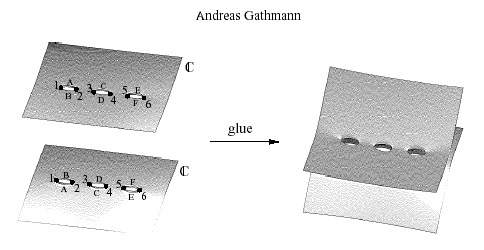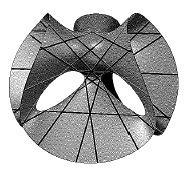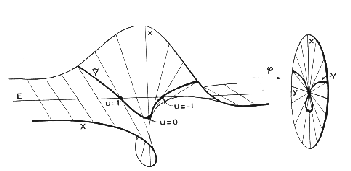Algebraic geometry combines these two fields of mathematics by studying systems of polynomial equations in several variables. Given such a system of polynomial equations, what sort of questions can we ask? Note that we cannot expect in general to write down explicitly all the solutions. So we are more interested in statements about the geometric structure of the set of solutions. For example, in the case of a complex polynomial equation of degree d, even if we cannot compute the solutions we know that there are exactly d of them (if we count them with the correct multiplicities). Let us now see what sort of "geometric structure" we can find in polynomial equations in several variables.
Let's look at the polynomial equation in two variables
y2=(x-1)(x-2)...(x-2n), where n is at least 1.
We can look at the set of solutions (x,y) that satisfy this equation. Recall that the complex plane is made up of numbers a + b i, where i is the square root of -1.
Question 1 Write down two real solutions that satisfy this polynomial (where x and y are both real).
Question 2 How many solutions can you find to the equation for x=0? Are these real or complex solutions? Write down these solutions.
Question 3 Let's say that n=1. Then we are looking at y2=(x-1)(x-2). How many solutions can you find to this equation for x=i? You should plug x=i into the equation and multiply out (note that i2 = -1) and then solve for y. Write down these solutions.
Let's go back to y2=(x-1)(x-2)...(x-2n). It is possible to write down all the solutions because the equation is (almost) solved for y already: we can pick x to be any complex numbers, and then get two values for y - unless x equals one of the roots (1, 2, 3, ... 2n) in which case we only get one value for y (namely 0).
So it seems that the set of solutions looks like two copies (a,b), (a,-b) of the complex plane with the two copies of each point 1,...,2n identified. While this is not quite true, the actual behavior is beyond the scope of this course (since the complex analysis is more difficult). So, the actual behavior is a more difficult, but we can use our naive understanding to visualize the set of solutions.
We start with two copies of the complex plane, and cut out holes to (roughly) represent the roots. We then glue the two copies of the plane together along these holes. This gives us a geometric picture of the set of solutions to this equation.

Question 4: What do we get if we instead consider y2=(x-1)(x-2)...(x-(2n-1))?
Answer questions 1 and 2 for this equation.
One of the trivial but common sources for misunderstandings is whether we count dimensions over the complex numbers (C) or the reals (R). We obtain complex curves (the dimension over C is 1) or real surfaces (the dimension over R is 2). This should help clarify the terminology from "The Proof" video that an elliptic curve (complex 1D curve that arises from a cubic, or degree 3, equation y2=x3 + ax +b ) gives a donut (real 2D surface). Skim through What is an Elliptic Curve
Let's look at a more complicated object, namely complex surfaces in 3-space (x, y, z can be complex). Look at the equation
1 + x3 + y3 + z3 - ( 1 + x + y +z)3 = 0 As the set of solutions (x,y,z) has real dimension 4, it is impossible to draw pictures of it that reflect its topological properties correctly. Usually, we overcome this problem by just drawing the real part, i.e. we look for solutions of the equation over the real numbers. This then gives a real surface in R3 that we can draw. We should just be careful about which statements we can claim to "see" from this incomplete geometric picture which shows the real part:

| In contrast to our previous examples, we have now used a linear projection to map the real 3-dimensional space onto the drawing plane. We see that there are some lines contained in S. In fact, one can show that every smooth cubic surface has exactly 27 lines on it. This is another sort of question that one can ask about the solutions of polynomial equations, and that is not of topological nature: do they contain curves with special properties (in this case lines), and if so, how many? This branch of algebraic geometry is usually called enumerative geometry. |
What we should learn from the examples above:
